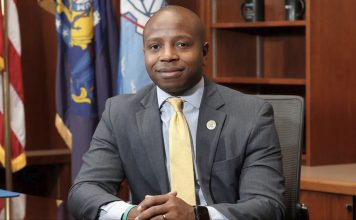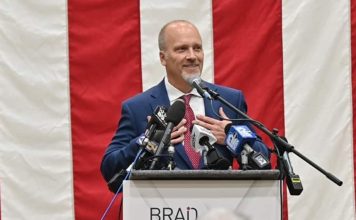Wisconsin Supreme Court Justice Brian Hagedorn has continued to disappoint conservatives by siding with the liberal wing of the court. That’s led more than one to dub him Wisconsin’s John Roberts, and that’s not meant in a flattering way.
That made us wonder: Who pushed Hagedorn as a conservative candidate for the supposedly non-partisan court in the first place? Many conservatives have been sorely disappointed that he’s repeatedly given the liberal wing of the court a majority. The answer:
Former Republican Gov. Scott Walker, in particular, deserves some of the blame if you don’t like Hagedorn on the court.
Three things seem to have convinced people Hagedorn would be a conservative leaning justice: His Christian faith was attacked in mainstream media stories focusing on his beliefs on homosexuality; he was Walker’s lawyer and appellate court appointee; and he was a clerk for former conservative Supreme Court Justice Michael Gableman and was endorsed by Gableman and other conservative justices. Conservative groups then backed his candidacy, although some later sat it out when controversy erupted over his old law school posts. There was an attempt to recruit another candidate, but it failed.
What Hagedorn has done since has increasingly riled many conservatives.
He sided with the liberal wing of the court in disagreeing when the majority (which still included conservative Dan Kelly) struck down Gov. Tony Evers’ safer-at-home order. With Kelly off the court, Hagedorn joined the liberals to keep the Green Party off the Wisconsin ballot, which some believe could have helped cost President Donald Trump the election in Wisconsin. More recently, he joined with the liberal wing again to reject Trump’s bid to fast track his election lawsuit to the state’s highest court. According to WPR, he also joined the liberals on the court “to delay a lawsuit seeking to purge thousands of names from the state’s voter list.”
Although defenders and Hagedorn himself say he is just following the rule of law, as he promised to do, the fact remains that conservative justices have repeatedly disagreed with his interpretations of the law, and the pattern is growing. The Trump campaign also had a different interpretation.
On the safer-at-home decision, he wrote, “The legislature may have buyer’s remorse for the breadth of discretion it gave to DHS in Wis. Stat. § 252.02. But those are the laws it drafted; we must read them faithfully whether we like them or not.” On the Trump lawsuit decision, Hagedorn wrote, “Even if this court has constitutional authority to hear the case straightaway, notwithstanding the statutory text, the briefing reveals important factual disputes that are best managed by a circuit court…Following the law governing challenges to election results is no threat to the rule of law. Furthermore, time is of the essence.” He argued that state statues mean the case needed to start in circuit court, essentially.
Conservative Justice Pat Roggensack, in a dissent joined by Annette Ziegler, disagreed with Hagedorn; she believed the Supreme Court had authority to immediately take up the case because of the Wisconsin Constitution. “I conclude that we have subject matter jurisdiction that enables us to grant the petition for original action pending before us,” she wrote. “Our jurisdiction arises from the Wisconsin Constitution and cannot be impeded by statute.” She also wrote that time was of an essence. The Trump campaign, in asking the Supreme Court to take the case directly, also grounded its request in the Wisconsin Constitution. The Wisconsin Constitution states that the Supreme Court has authority to hear “original actions and proceedings.”
So who got us Brian Hagedorn?
1. Hagedorn Worked for Scott Walker & Was His Pick for the Court, According to Published Reports
If you don’t like Hagedorn as a justice, some blame has to go to former Republican Gov. Scott Walker. Hagedorn has strong ties to Walker. He was Walker’s chief legal counsel from 2011 until 2015, according to Wisconsin Public Radio.
Walker then appointed him to the District 2 Court of Appeals, which set him up for a bid for the state Supreme Court.
At the time, Urban Milwaukee’s Bruce Murphy wrote, “Hagedorn was Walker’s pick to run for the Supreme Court but once Walker lost and was no longer the party’s state leader there were Republicans who began to express doubts.” He also noted, “Hagedorn was the clear choice for the state’s highest court by the head of the state Republican Party and a governor with a good chance of being reelected, so the state’s conservative establishment immediately rallied around Hagedorn.”
There were some qualms behind the scenes. Bill McCoshen, a Republican consultant, said on PBS in 2019 that “there was a last-minute effort to find another candidate to get in that race at the end of December. That was unsuccessful. Hagedorn has been in that race essentially for nine months. I’m concerned about that race moving forward.”
As it stood, Hagedorn did not even face a Republican primary candidate.
According to the Wisconsin Democracy Campaign, Justice Hagedorn “was appointed to the Waukesha branch of the Wisconsin Court of Appeals in 2015 by Republican Governor Scott Walker and reelected in 2017. He was first elected to the Supreme Court in 2019. There was no primary.”
According to Urban Milwaukee, Hagedorn criticized outgoing liberal Supreme Court Justice Shirley Abrahamson, saying that she “would vote against me because she did not like my client or my client’s politics.”
The liberal Shepherd Express quoted Walker as saying of Hagedorn, “Everything I’ve seen in the past is he’s going to be consistently conservative. Not politically. He’s going to consistently be in the camp of believing the Constitution is the ultimate guide.” The story quotes Hagedorn as saying, “I’m an originalist and a textualist. Textualism means the law means what is says. Originalism points to what it meant when drafted.”
Hagedorn also worked as an assistant attorney general under AG JB Van Hollen. He also worked for the law firm Foley & Lardner.
2. Conservative Justices Endorsed Hagedorn Right Out of the Gate
According to the 2018 Associated Press story on his announcement, Hagedorn was endorsed by two conservative Justices: Rebecca Bradley and Daniel Kelly.
Gableman, for whom he once clerked, also endorsed him. Big endorsements like that right out of the gate made conservatives think Hagedorn would have a conservative judicial philosophy.
3. Hagedorn’s Campaign Was Backed by Conservative Groups
According to Wisconsin Public Radio, the conservative group Americans for Prosperity and the Republican State Leadership Committee financially supported Hagedorn’s 2019 campaign. It’s worth noting that his opponent was liberal Lisa Neubauer by that point, though, so they didn’t have another horse to back at that point.
Madison.com reported that the Republican State Leadership Committee put more than $1 million into the race after outside liberal groups resulted in spending supporting Neubaer to widely outpace that for Hagedorn.
The Wisconsin Democracy Campaign says Hagedorn raised $1,723,398, whereas Neubauer raised $2,018,259. Outside groups spent more than $4 million on “issue ads.”
Top spending groups were listed as:
Greater Wisconsin Committee, $2.28 million (supporting Neubauer)
Republican State Leadership Committee – Judicial Fairness Initiative, $1.25 million
Americans for Prosperity IE Committee, $292,000
According to Wisconsin Public Radio, Hagedorn was criticized during the campaign for law school blog posts he wrote that “compared homosexuality to bestiality” and labeled Planned Parenthood a “wicked organization.”
He was also criticized for founding a private Christian school in Delafield “where the code of conduct prohibits teachers, students and parents from participating in homosexual activity,” according to WPR.
Isthmus reported that the blog posts caused the Wisconsin Realtors Association “to revoke its endorsement and Wisconsin Manufacturers and Commerce to sit the race out.” However, the criticism also made some conservatives think he was being attacked for his Christian beliefs.
Table of Contents





















![WATCH: Elon Musk Town Hall Rally in Green Bay [FULL Video]](https://www.wisconsinrightnow.com/wp-content/uploads/2022/04/Elon_Musk_3018710552-356x220.jpg)











